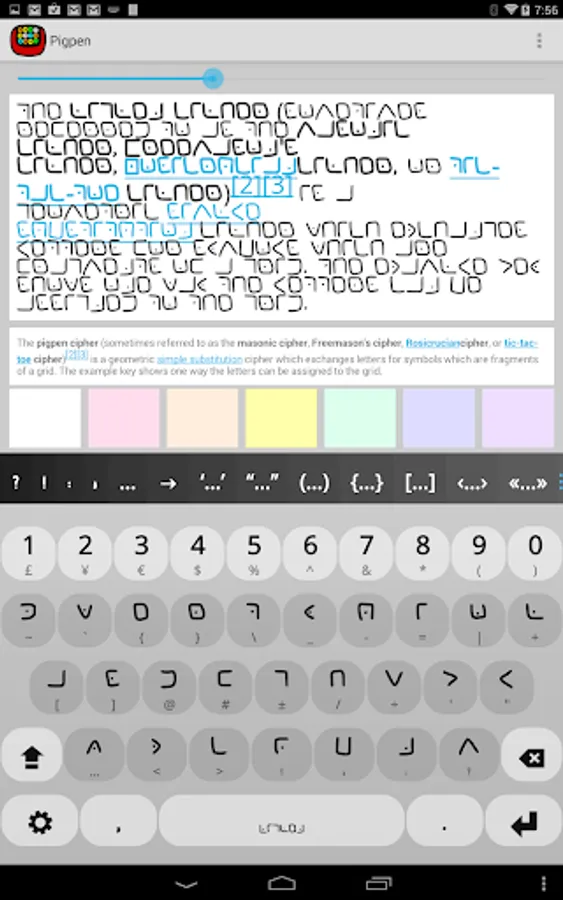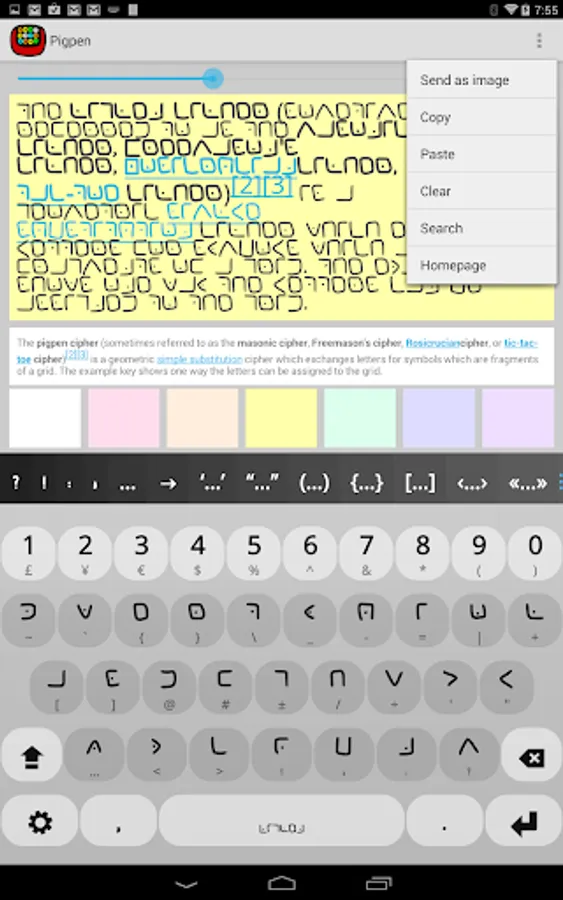Pigpen Keyboard plugin
Honso
2.7 ★
store rating
5,000+
downloads
Free
AppRecs review analysis
AppRecs rating 1.7. Trustworthiness 52 out of 100. Review manipulation risk 33 out of 100. Based on a review sample analyzed.
★☆☆☆☆
1.7
AppRecs Rating
Ratings breakdown
5 star
31%
4 star
0%
3 star
12%
2 star
12%
1 star
45%
What to know
⚠
Mixed user feedback
Average 2.7★ rating suggests room for improvement
⚠
Review quality concerns
50% of sampled 5-star reviews are very short
About Pigpen Keyboard plugin
pigpen cipher font plugin for Multiling O Keyboard. This is not an independent app, please install OKeyboard along with this plugin.
Instruction:
⑴ Install this plugin and Multiling O Keyboard.
⑵ Run O Keyboard and follow its setup guide.
⑶ Slide space bar to switch languages.
Please email if you have any questions.
Wikipedia:
The pigpen cipher (sometimes referred to as the masonic cipher, Freemason's cipher, or tic-tac-toe cipher)[2][3] is a geometric simple substitution cipher which exchanges letters for symbols which are fragments of a grid. The example key shows one way the letters can be assigned to the grid.
The use of symbols is no impediment to cryptanalysis, and this system is identical to that of other simple monoalphabetic substitution schemes. Due to the simplicity of the cipher, it is often included in children's books on ciphers and secret writing.[4]
The exact origin of the cipher is uncertain,[5] but records of this system have been found which go back to at least the 18th century. Variations of this cipher were used by both the Rosicrucian brotherhood[5] and the Freemasons, though the latter used it so often that the system is frequently called the Freemason's cipher. They began using it in the early 18th century to keep their records of history and rites private, and for correspondence between lodge leaders.[3][6][7] Tombstones of Freemasons can also be found which use the system as part of the engravings. One of the earliest stones in Trinity Church Cemetery in New York City, which opened in 1697, contains a cipher of this type which deciphers to "Remember death" (cf. "memento mori"). George Washington's army had documentation about the system, with a much more randomized form of the alphabet. And during the American Civil War, the system was used by Union prisoners in Confederate prisons.[5]
Photo: Gray Lake by Romain Guy
Instruction:
⑴ Install this plugin and Multiling O Keyboard.
⑵ Run O Keyboard and follow its setup guide.
⑶ Slide space bar to switch languages.
Please email if you have any questions.
Wikipedia:
The pigpen cipher (sometimes referred to as the masonic cipher, Freemason's cipher, or tic-tac-toe cipher)[2][3] is a geometric simple substitution cipher which exchanges letters for symbols which are fragments of a grid. The example key shows one way the letters can be assigned to the grid.
The use of symbols is no impediment to cryptanalysis, and this system is identical to that of other simple monoalphabetic substitution schemes. Due to the simplicity of the cipher, it is often included in children's books on ciphers and secret writing.[4]
The exact origin of the cipher is uncertain,[5] but records of this system have been found which go back to at least the 18th century. Variations of this cipher were used by both the Rosicrucian brotherhood[5] and the Freemasons, though the latter used it so often that the system is frequently called the Freemason's cipher. They began using it in the early 18th century to keep their records of history and rites private, and for correspondence between lodge leaders.[3][6][7] Tombstones of Freemasons can also be found which use the system as part of the engravings. One of the earliest stones in Trinity Church Cemetery in New York City, which opened in 1697, contains a cipher of this type which deciphers to "Remember death" (cf. "memento mori"). George Washington's army had documentation about the system, with a much more randomized form of the alphabet. And during the American Civil War, the system was used by Union prisoners in Confederate prisons.[5]
Photo: Gray Lake by Romain Guy

